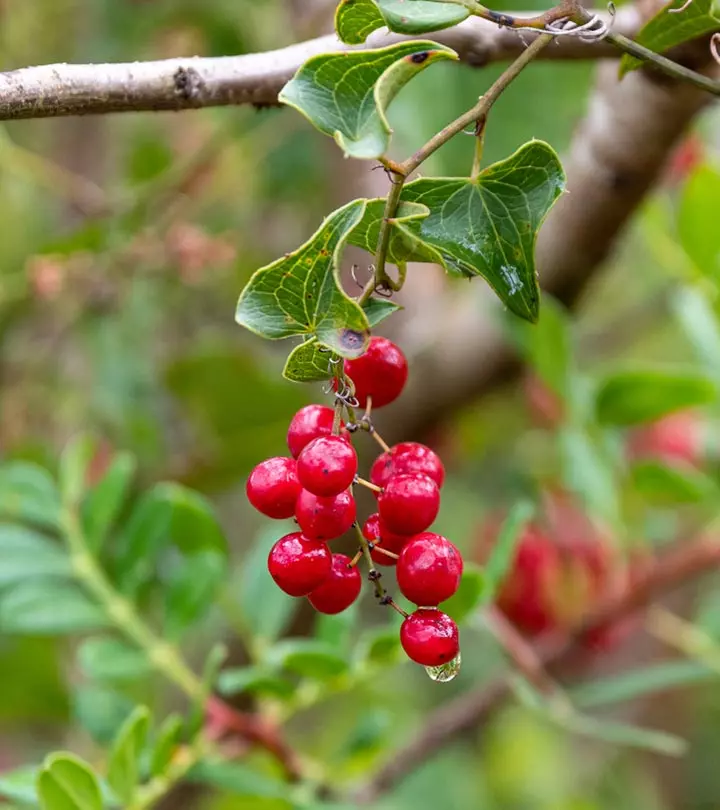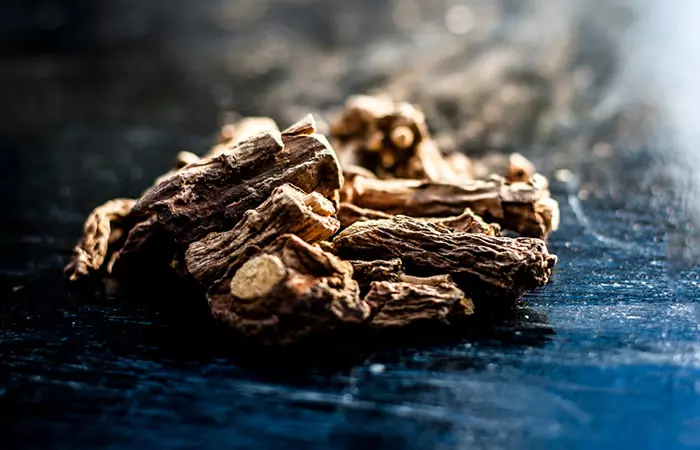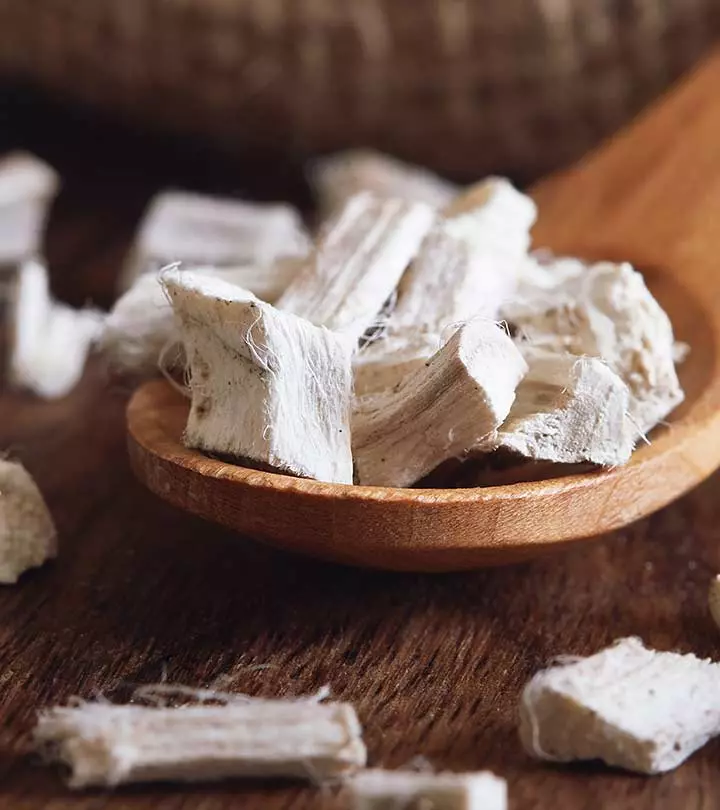Sarsaparilla: Benefits, Possible Side Effects, And Recipes
This sweet-tasting plant can do wonders for your health in the long run!

Image: Shutterstock
Those who grew up watching “The Smurfs” might recall Smurfberries – the bright red berries, as they are called in the show. They are sarsaparilla. Sarsaparilla benefits have been known by Southasians for centuries. Many Asian cultures have used this plant in natural remedies to treat syphilisi An eventually life-threatening curable bacterial infection that usually spreads through sexual activity, starting off as a painless sore. , gout, and other skin conditions (1). Sarsaparilla is a traditional medicinal plant belonging to the Smilax family and is also known as Salsepareille in French. This article discusses seven ways in which sarsaparilla can benefit your health, its potential side effects, and the precautions you should keep in mind when taking sarsaparilla. Read on.
 Know Your Ingredient: Sarsaparilla
Know Your Ingredient: SarsaparillaWhat Is It?
A bright-red berry that tastes sweet, akin to a combination of vanilla and licorice.
What Are Its Benefits?
Sarsaparilla helps treat syphilis, psoriasis, and arthritis.
Who Can Use It?
People experiencing rheumatoid arthritis, psoriasis, and cancer patients.
How Often?
A cup or two of sarsaparilla tea can be had daily.
Caution
As sarsaparilla has diuretic properties, avoid its consumption when dehydrated so as not to increase water loss.
In This Article
What Is Sarsaparilla?

Sarsaparilla is a plant that is native to America, especially in regions such as South America, Mexico, Jamaica, the Caribbean, and the West Indies. While Native Americans have used the sarsaparilla plant for treating leprosyi A chronic, curable bacterial infection that mainly affects the skin and causes nerve damage and skin lesions. for centuries, European explorers took the sarsaparilla root back to Europe and incorporated it in the treatment of syphilis. Also known as khao yen, or jupicanga, this plant was used in the west to make a drink called sarsaparilla, which is mixed with sassafras and is the precursor to modern root beer. Likened to the taste of vanilla and licorice, this sweet-tasting plant can be a perfect addition to your tea or soda.
 Trivia
TriviaNow that you know what sarsaparilla is, let us read about the different ways sarsaparilla benefits us in the long run.
Key Takeaways
- Sarsaparilla is an effective alternative medicine that has been used for treating syphilis and leprosy in Asia, Europe and native America for centuries.
- It has anti-cancer and blood purification properties and can also help in managing psoriasis, arthritis, and liver damage.
- The best way to consume sarsaparilla is by drinking its tea.
- However, caution is advised as it may trigger asthma and also exhibits diuretic activity.
7 Health Benefits Of Sarsaparilla
Sarsaparilla has been used by ancient healers for centuries to heal different ailments such as syphilis, cold, and arthritis.
While modern medicine is yet to investigate these claims, researchers have been able to study some of the benefits of sarsaparilla root. Let us see what Science has to say about them.
1. May Help In Fighting Cancer
A lab study was conducted to see if sarsaparilla extract was effective in slowing down the migration and invasion of cancer cells. The researchers found that the extract was successful in inhibiting the migration and invasion of the cancer cells (2).
2. May Help In Reducing Psoriasis

Psoriasis is a disease that is characterized by red or white cell patches all over the skin. These cell patches cause irritation and itching caused by Th17 cells which have been linked to psoriasis (3). A study was conducted to see the effect of astilbin on skin lesions caused by psoriasis. Astilbin is a compound found in plants such as sarsaparilla that is said to be rich in antioxidants. Mice with skin lesions were given 25/ 50 mg/kg astilbin and the experts saw an improvement in the lesions (4). While the results are promising, more studies on humans need to be conducted to solidify this claim.
3. May Be A Potential Anti-inflammatory And Analgesic Agent
Research says sarsaparilla may have the potential to be an anti-inflammatory and analgesic agent.
A study was done to investigate the anti-inflammatory and analgesic properties of the extract obtained from Jamaican sarsaparilla. When compared to saline and vegetable oil, sarsaparilla extract showed significant anti-inflammatory and analgesic activity, suggesting that this plant could become a potential player in modern medicinal treatment (5).
4. May Play A Role In The Treatment Of Arthritis

Sarsaparilla has been used across cultures in Southeast Asia for centuries in the treatment of arthritis. Modern Science has tried to find evidence that supports this claim. A study examined the effect of turmeric, sarsaparilla, and vitamin D in acupuncture for the treatment of psoriatic arthritisi Inflammation, tenderness, or stiffness of one or more joints, causing pain, and it mainly affects people who have psoriasis. . A patient diagnosed with psoriatic arthritis was administered acupuncture with a mixture of turmeric, sarsaparilla, and vitamin D once a day. The results showed a reduction in the symptoms such as edema and stiffness, suggesting that sarsaparilla may play a role in the treatment of arthritis (6).
5. May Provide Protection Against Liver Damage
A study was done to see the effect of ethanol extract taken from sarsaparilla on rats with liver damage. The rats were given doses between 0.5 to 3.0 g/kg and were monitored for 24 hours. Researchers saw that the extract inhibited the rise of GPT, an enzyme associated with liver damage, indicating that sarsaparilla extract may provide protection against liver damage (7).
6. May Be A Potential Antimicrobial Agent
Research indicates that sarsaparilla shows antimicrobial activity that is essential for fighting foreign pathogens that enter the body. A study was done to see the antimicrobial activity of sarsaparilla. The results suggested that there were 18 compounds that showed antimicrobial activity against 6 bacteria and one fungus, suggesting that it may be used as an antimicrobial agent for treatment (8).
7. May Have Diuretic Properties
While more research needs to be done to substantiate this, preliminary studies have shown that sarsaparilla may exhibit diuretici A substance designed to increase the production of urine or help rid the body of extra fluids and salts. properties. A diuretic is a substance that increases the production of urine in our bodies. A study was done to examine the diuretic activity of sarsaparilla on laboratory animals. In this study, sarsaparilla extract was orally administered to study the diuretic activity on the animals. The extract demonstrated a significant amount of diuretic activity (9).
From the above section, you can see that there is growing evidence that sarsaparilla benefits us in various ways. Let us now look into the possible side effects and allergies of sarsaparilla.
Possible Side Effects And Allergies Of Sarsaparilla

Various cultures across the world have been using sarsaparilla for ages. There is limited evidence that suggests possible side effects of sarsaparilla, though you should keep a few things in mind before you consume it.
- Due to studies showing that sarsaparilla exhibits diuretic activity, it is recommended that you avoid consuming it when you are dehydrated (9).
- A study was conducted that suggests that sarsaparilla root dust may cause asthma problem in occupational environments (10).
As you can see, research indicates that consumption of sarsaparilla root dust may lead to possible side effects such as asthma. More studies will need to be conducted to understand if sarsaparilla produces any other side effects. Let us look at the various ways in which you can incorporate sarsaparilla into your diet.
How To Take Sarsaparilla
Reap sarsaparilla root benefits in a delectable way by incorporating it into delicious meals. Since the taste of sarsaparilla has been equated with the likes of licorice and vanilla, this sweet-tasting herb can be added to a hot cup of tea to give you a nice boost in the morning. Let’s look at a simple recipe of sarsaparilla tea that you can make at home.
1. Sarsaparilla Tea

Ingredients
- 1 teaspoon of shredded sarsaparilla root
- 1 cup of hot water
- 1 teaspoon of honey
Instructions
- Bring a saucepan and add 1 cup of water and bring it to a boil.
- Chop and shred the pieces of the root as finely as possible.
- Add 1 teaspoon of the chopped root to a teapot.
- Pour the hot water over the chopped root and stir it properly.
- Allow it to steep for 15 minutes.
- Strain the tea into a cup.
- Add 1 teaspoon of honey and enjoy your cup of tea warm.
 Quick Tip
Quick TipWith this simple recipe of sarsaparilla tea, you can enjoy a nice cup of tea and experience the different ways sarsaparilla benefits you.
You can also make sarsaparilla soda and serve it with cream soda. Ricky, a food blogger, prepared this soda from scratch and found it to be the tastiest drink she had ever made. She adds, “The resulting brew was sweet, herbal, slightly spiced (from the cardamom), and very refreshing (i).”
2. Sarsaparilla Supplements
These supplements are generally available in the form of capsules or extracts. They can be taken with or without food, depending on personal preference. The timing of consumption can vary – some prefer taking it with meals to minimize the risk of digestive discomfort, while others take it between meals to maximize absorption.
The dosage recommendations of these supplements vary widely. However, it is advisable to consult a healthcare professional or follow product-specific instructions as dosages may differ based on the supplement’s concentration and intended use.
Sarsaparilla is generally considered safe for most individuals, but those with pre-existing medical conditions or those taking medications should consult a healthcare provider before use to avoid any potential adverse effects.
Let us look into some of the precautions to keep in mind before consuming sarsaparilla.
Precautions To Consider While Taking Sarsaparilla
While sarsaparilla herb is relatively safe for consumption, there are a few precautions you should consider while taking sarsaparilla. While there is no research to support this, high concentrations of sarsaparilla may lead to an allergic reaction and stomach upset. It is highly advised that you consult a doctor for the right dose of sarsaparilla consumption. Additionally, if you are pregnant, breastfeeding, or planning surgery, seek medical advice before using sarsaparilla. Its effects on these groups of people have not been thoroughly studied.
The right precautionary steps can help you select the best sarsaparilla while ensuring safe and effective use. Scroll down to know more.
How To Source Quality Sarsaparilla
- Select genuine and potent sarsaparilla herbs made, such as Smilax regelii (Honduran) or Smilax ornata (Jamaican).
- Make sure sarsaparilla is cultivated naturally and isn’t contaminated or treated with pesticides. Look for wildcrafted or organic varieties.
- Purchase these herbs from reliable vendors or specialized health shops to ensure quality and authenticity.
- Select the form that best suits your needs like liquid extracts or tinctures provide a concentrated option, powdered root is convenient but prone to adulteration, and dried root is great for teas.
- Look for the Latin name (Smilax spp.) on the label to avoid low-quality items, and make sure there are no artificial additives or fillers.
- Store the herb properly in an airtight glass jar out of direct sunlight and in a cool, dry environment to keep it fresh.
Infographic: 5 Benefits Of Sarsaparilla
The sarsaparilla plant has a long history of traditional use across many cultures due to its anti-inflammatory and analgesic properties. The infographic below lists the five benefits of sasparilla. Check it out and discover how this plan can help you.

Illustration: StyleCraze Design Team
Summary
Sarsaparilla is a sweet, nutritious bright red berry found on the American continent. These berries are loaded with potent antioxidants, vitamins, and minerals and have been used in traditional medicine to help promote overall health improvement. The skin health benefits of sarsaparilla include reduced psoriasis skin lesions and decreased inflammation. In addition, these berries have natural antimicrobial and diuretic properties for effective detoxification. Sarsaparilla is a herbal medicine that can be infused into tea and tastes similar to vanilla or licorice. However, excess intake of sarsaparilla may trigger allergic reactions or cause gastrointestinal issues. If you experience any adverse effects, limit its use and seek medical advice.
Frequently Asked Questions
Is sarsaparilla good for the kidneys?
There is a lack of scientific evidence suggesting that sarsaparilla is good for the kidneys.
Does sarsaparilla have estrogen?
No. There is no estrogen in sarsaparilla, although anecdotal evidence suggests that its sterols may mimic estrogen’s effects.
Is sarsaparilla high in iron?
Anecdotal evidence suggests that sarsaparilla is high in iron and its extract or supplements may help deal with iron deficiency.
Is sarsaparilla good for the immune system?
Yes, sarsaparilla may help modulate immunity. It possesses anti-inflammatory and liver-protecting properties (11).
Is sarsaparilla good for hair growth?
There is a lack of scientific evidence suggesting that sarsaparilla is good for your hair.
Illustration: Sarsaparilla Benefits That You Should Take A Note Of

Image: Stable Diffusion/StyleCraze Design Team
Discover the benefits of using wild sarsaparilla with this video! Check it out to learn how to use it in various ways. Get ready to explore its unique flavor and health benefits.
Personal Experience: Source
StyleCraze's articles are interwoven with authentic personal narratives that provide depth and resonance to our content. Below are the sources of the personal accounts referenced in this article.
i. Recipe: Homemade Sarsaparilla Soda from Scratchhttps://sodamancy.blogspot.com/2011/09/recipe-homemade-sarsaparilla-soda-from.html
References
Articles on StyleCraze are backed by verified information from peer-reviewed and academic research papers, reputed organizations, research institutions, and medical associations to ensure accuracy and relevance. Read our editorial policy to learn more.
- Sarsaparilla (Smilax Glabra Rhizome) Extract Inhibits Migration and Invasion of Cancer Cells by Suppressing TGF-β1 Pathway
https://www.ncbi.nlm.nih.gov/labs/pmc/articles/PMC4351248/
- Sarsaparilla (Smilax Glabra Rhizome) Extract Inhibits Cancer Cell Growth by S Phase Arrest Apoptosis and Autophagy via Redox-Dependent ERK1/2 Pathway
https://pubmed.ncbi.nlm.nih.gov/25732255/ - Th17 Cells in Human Disease
https://www.ncbi.nlm.nih.gov/labs/pmc/articles/PMC3299089/ - Astilbin Inhibits Th17 Cell Differentiation and Ameliorates Imiquimod-induced Psoriasis-like Skin Lesions in BALB/c Mice via Jak3/Stat3 Signaling Pathway
https://pubmed.ncbi.nlm.nih.gov/26784569/ - Investigation of the Anti-inflammatory and the Analgesic Effects of the Extracts from Smilax Ornata Lem. (Jamaican sarsaparilla) Plant
https://pubmed.ncbi.nlm.nih.gov/31063818/ - Treatment of Psoriatic Arthritis with Acupuncture Turmeric ( Curcuma longa) Sarsaparilla ( Smilax officinalis) and Vitamin D: A Case Report
https://pubmed.ncbi.nlm.nih.gov/33362443/ - Hepatoprotective and Safety Evaluation Studies on Sarsaparilla
https://www.researchgate.net/publication/232082983_Hepatoprotective_and_Safety_Evaluation_Studies_on_Sarsaparilla - Chemical Constituents from the Rhizomes of Smilax Glabra and their Antimicrobial Activity
https://pubmed.ncbi.nlm.nih.gov/23698042/ - Diuretic Activity of Some Smilax Canariensis Fractions
https://pubmed.ncbi.nlm.nih.gov/22289346/ - Occupational Asthma Caused by Sarsaparilla Root Dust
https://www.jacionline.org/article/S0091-6749(96)70214-2/fulltext - Sarsaparilla (Smilax Glabra Rhizome) Extract Inhibits Migration and Invasion of Cancer Cells by Suppressing TGF-β1 Pathway
https://www.ncbi.nlm.nih.gov/pmc/articles/PMC4351248/
Read full bio of Gabrielle Kane
Read full bio of Varsha Patnaik
Read full bio of Ravi Teja Tadimalla
Read full bio of Payal Karnik






















Community Experiences
Join the conversation and become a part of our empowering community! Share your stories, experiences, and insights to connect with other beauty, lifestyle, and health enthusiasts.